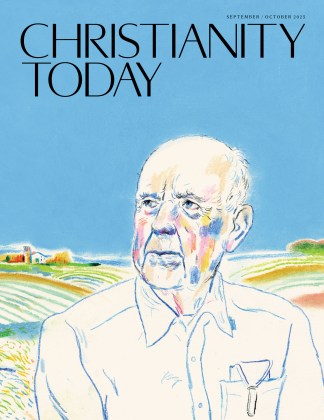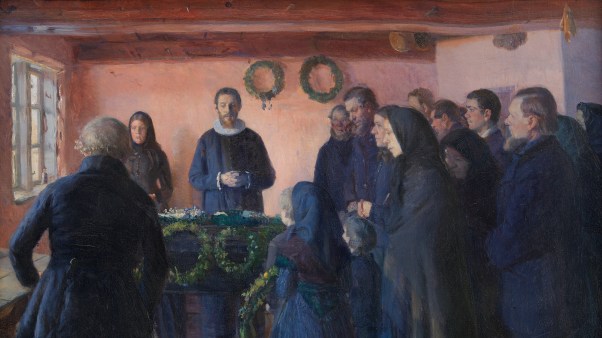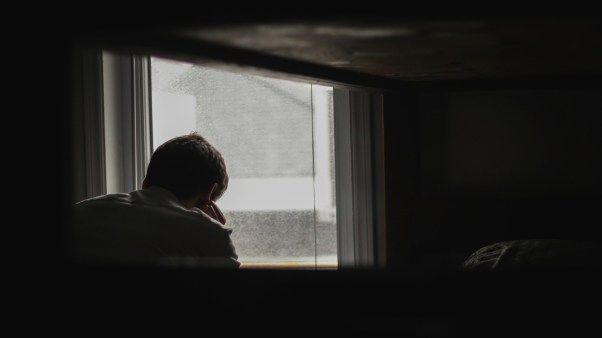The church doesn’t always feel like my home, but on Saturday, September 28, 2024, it did.
My first hint that a storm was coming was the morning before. I had planned a trip to Waffle House with friends—hash browns, over-medium eggs, and coffee. But I was worried about the forecast, which predicted high winds, so we canceled. I still went to work. But after the power in the office went out—my second hint—my coworkers and I decided it was a good time to leave.
By Saturday, I was worried. I was safe in my Johnson City, Tennessee, apartment but was starting to understand the extent of the damage Hurricane Helene was causing across the region. I heard about the destroyed Unicoi County Hospital, where a helicopter saved patients and nurses from the roof. I heard of people gone missing whose bodies wouldn’t be found for more than a month.
I texted a former professor who pastors a church in Unicoi County, a 15-minute drive from me. Its members were safe, but the community was torn up—a factory crushed by the river, uprooted trees strewn like driftwood across the interstate, another church with pews buried in mud. My professor was wondering how his congregation could help.
All over the country, in the aftermath of fires and mudslides and tornadoes and horrible floods like those that slammed the Texas Hill Country this summer, more and more pastors are coming to grips with the reality of long-haul recovery. According to the National Centers for Environmental Information, the United States faced five separate billion-dollar disaster events in 2000. In 2024, it faced 27. Hurricane Helene was one of them, a Category 4 hurricane with heavy rains and 140-mph winds that killed 250 people.
Throughout the storm, my wife and I were safe. We had what we needed. But I knew there were countless other people who did not. I sat on my couch, worried and powerless.
September 28 opened up an ache that turned into a question: How does help get to the people who need it?
That Saturday, Sue Ford clocked out from her job in Elizabethton, Tennessee, for the last time. The Doe River was overflowing its banks, both in Elizabethton and in nearby Hampton, where she lived. Her boss at the nursing home said Ford couldn’t leave to check on her chihuahuas. So she quit.
The dogs were safe, but a nearby neighborhood was flooded. So Ford picked up a heavy-duty rope from Brown’s Hardware & Grocery and fired up the skid-steer loader she and her husband used for their side hustle pavement business. Edging alongside houses, she tied the rope to porches and guided stranded people through the floodwaters to the skid-steer’s bucket. Ford saved ten people, two dogs, and a cat.
Next on the list was a drive up the nearby Roan Mountain to check on friends and family who didn’t have cell service, Wi-Fi, clean water, or heat. The bridges had washed out; they were stuck in their houses. Ford wasn’t surprised: “Honey, when it comes down that Doe, there ain’t nothing gonna stand in its way.”
Fortunately, Sue Ford knows how to get places—specifically, she knows the creases in Roan Mountain after living in the area for 49 years. For weeks after the storm, she piled food, water, and kerosene onto a utility vehicle and weaved through fallen trees to Tiger Creek. If someone needed a hospital visit, Ford and the dogs gave them a ride.
But eventually, she started running out of resources. She hoped that the Bristol Motor Speedway—the racetrack turned into a donation hub—might supply some food. When she drove 40 minutes there to check, she discovered the venue was distributing items to registered nonprofits only.
That made sense, but it was still frustrating. Ford knew who had needs. But she couldn’t get the supplies. Another thing about Sue Ford: She’s not one to quit easily. She headed back to Elizabethton, to the faith-based nonprofit Assistance and Resource Ministries (ARM). There she met director Michelle Kitchens, the woman in charge of coordinating volunteers and organizing donations who also checks in on about 200 homeless clients, keeps records, and folds clothes in a pile on her desk. Ford needed Kitchens’s help with securing a nonprofit designation; Kitchens knew which documents needed to be submitted.
Before long, Ford and a crew of volunteers on side-by-sides and four-wheelers were storing Speedway-provided supplies in Hampton and then driving them to Tiger Creek. On Thanksgiving Day, they delivered turkeys.
By March, when Ford and Kitchens drove me around Carter County, things were quieter. Ford pointed out trickling creeks that had erupted into rivers, assuring me we wouldn’t get lost. “And if you get lost, find a possum,” she said, “because it always finds a road.”
In the afternoon, we visited Ford’s aunt, who’d received a generator from ARM. It had been six months since the flood, but Kitchens still asked if she needed anything. Three hours later, the women were headed back up to Roan Mountain with dog pads, Coke, and two propane tanks.
It takes years of membership in a community to learn how to take care of people like Ford did. But it also takes local organizations, churches, and nonprofits to connect resources with knowledge. It takes a speedway warehousing boxes of cereal and someone who can jump through bureaucratic hoops.
Personal knowledge, organizational resources, trust: The convergence of these is what gets food up to an aunt in the woods.
On September 30—the Monday just after the storm—I accompanied a friend to an emergency response center. When we arrived, lots of volunteers were already there. The people at the check-in table told me I could add my name to the sign-in sheet, and they’d call if they needed more help.
The sheet asked about skills or resources; I had studied English and humanities in college and then worked for an arts center. I don’t remember what I wrote, but I knew they weren’t going to call me. I waited in the emergency center in case anybody needed the two hands of a 23-year-old. They didn’t. There was that feeling again: wanting to help but not knowing how.
Ford had known. Kitchens had known. Marsha Van Rijssen and Jill Rhinehart knew too.
Across the mountain range in Asheville, North Carolina, Van Rijssen helps with the weekly meals at Groce United Methodist Church. When Hurricane Helene knocked the power out, her mind went to the food in the freezer. She knew it would spoil soon. So she drove to the church and knocked on the parsonage door.
“I knew the kitchen there,” Van Rijssen said. “I know where everything’s at…. And it just began.”
Van Rijssen and her children, along with Rhinehart, the pastor, got to work. They put up a sign on the street corner. They set up a buffet table under the breezeway and more tables in the parking lot. The first day they served around 200 meals. By the second day it was 500. Van Rijssen invited a bunch of local teenagers to help.
And the food was abundant. Every year, Groce UMC partners with a local farm for a pumpkin sale; that farm supplied fresh produce. Downtown businesses donated food from powerless freezers—Brazilian cuisine, steaks, pies. A chef showed up and started cooking for free.
In her weeks serving meals, Rhinehart noticed guests walking around, dazed. One man in his early 30s didn’t know she was the reverend but wanted to tell her what the lunches had meant to him. “If I can just get to two o’clock, I can go over there and eat and I can be okay,” she remembers the man saying.
My favorite part of the Groce UMC story is the teenagers. I’m guessing they weren’t particularly skilled at baking casseroles, but they could scoop food with a spatula. I felt a lot closer to them than the adults. Each day, those teenagers served food to hundreds of people, because they had the church.
That first week after Helene hit, I kept my ears perked for ways to help. There were email lists to join, social media accounts to follow, and news stories to read. But it was genuinely difficult to discern which places would benefit from the help of a random 23-year-old with no relevant skills.
The leads I followed came from my church. The chair of our benevolence committee sent an email detailing places that needed help—the church camp where the youth group goes each summer, a flooded church in Erwin, First Baptist Church Roan Mountain.
When I arrived at First Baptist, the building was full of donations—water bottles in the driveway, cleaning supplies in the side hallway. First Baptist members piled chainsaws onto ATVs so they could clear the roads.
I’ve used a chainsaw before, but not enough for them to hand me one after a hurricane. No one wants me cooking. Once again, I approached the check-in table. In this case, the pastor’s mother-in-law was kind. She gave me a job carrying boxes to cars.
While loading supplies into trunks, I finally understood one of the most important things a church provides after disaster: a system. I offered no expertise, but I could slot into a role, step into the flow of donations and volunteers, and become one of many who were serving as the hands and feet of Jesus.
In Reorganized Religion, religion reporter Bob Smietana detailed how churches and denominations have been crucial to disaster response in the US. “The whole system was a well-oiled machine,” he reported of Hillcrest Baptist Church near Savannah, Georgia, which operated as a relief headquarters after Hurricane Sally.
A few days after my trip to First Baptist, I joined my church’s youth group at ARM—where Kitchens is the director—to organize clothes. Every Wednesday and Thursday for years, people in need have come to ARM to pick up mac and cheese for kids and camping meals they can cook outside or to look through clean clothes. After the hurricane, being nice and hardworking wasn’t enough to effectively distribute supplies. Kitchens and her team had been getting good at service for 27 years, as well as getting a network of area churches like mine accustomed to donating and volunteering.
 Illustration by Mark Harris
Illustration by Mark Harris“Most people in our community will trust one of our churches far more than they will trust any kind of organization or any kind of government agency,” said Quana Roberts, who coordinated post-Helene home repair projects out of Harmony Free Will Baptist Church in Hampton, Tennessee. Volunteer crews came from across the country and slept in Harmony’s fellowship hall; Roberts sent them to muck out mud and put up drywall. Harmony had a plumber and electrician in its pews who were willing to work on weekends. Months later, the church was tackling its third full community rebuild project. All the logistics went through Roberts’s phone.
For 17 years before the storm, Harmony had served its neighbors through an annual Back to School Bash, giving away 1,500 fully stocked backpacks in an event more like a carnival than a trip to Walmart. “You get the bounce house. You get to go pet the goats, and everything’s free,” Roberts said. Families came to the church for the bounce house. When it came time to ask for help after a hurricane, they knew who to call.
“There is no organization more responsible in Northeast Tennessee for the [post-Helene] recovery that has happened than churches,” said Brad Parker, then director of disaster recovery for Eastern Eight, a nonprofit that focuses on housing in East Tennessee.
Denominational ministries like Tennessee Baptist Disaster Relief, Mennonite Disaster Service, and Lutheran World Relief have sent out volunteers for years; on a congregational level, members have learned to work together. They know what’s expected of them—this is what their churches do.
Amy Phillips, the Western North Carolina response coordinator for Lutheran Disaster Response Carolinas, confirmed that many Lutheran congregations do regular service projects with Habitat for Humanity. Some congregations will go on two to three disaster trips a year. “So it’s pretty common,” she said, “for that construction piece to be kind of second nature to how they serve in the community.”
In those first days after Helene, I witnessed the encouraging reality that lots of people want to help after a disaster. It takes a local organization, though, to turn that desire into action, into hot food and repaired roofs. The studs of these systems—the weekly volunteer commitments, the storage facilities, and the phone number lists—are put in place long before disaster strikes. “For decades,” Smietana wrote, “the federal government’s disaster relief strategy has been built around the assumption that trained volunteers from faith-based groups will be among the first on the ground when disaster strikes.”
But that assumption may not hold. The number of people leaving organized religion has been rising for decades; my generation, Gen Z, is the most religiously unaffiliated of any previous cohort. Fewer people are church members, and church membership is aging. “My volunteer base is in the upper 70s to 80s [in age],” Kitchens said about ARM. “So there’s a lot of things they can’t do. That’s why I’m here seven days a week.”
After what I saw in the aftermath of Helene, it’s no surprise a study from the Pew Research Center found that “nones” are less likely to volunteer. It might be because they don’t know where to go. They don’t have the email list to check, the board member to call, the system to lean on, or the trust that a local ministry is reputable.
I worry my generation might lose access to the systems required to care for our neighbors. And that means, as natural disasters increase in frequency and severity, fewer neighbors will be helped.
Michala Watson told me her flood story at the hotel in Asheville, North Carolina, where she works. Six months later, the parking lot was still covered in silt.
At 6 a.m. on September 27, she awoke to a crashing sound. She jumped out of bed, checked on her daughter, and looked outside. A tree had missed her basement window by less than a foot; the Swannanoa River near her house was overflowing.
Watson was scheduled to work—she was at a different hotel then—but a fallen tree was blocking her driveway. She told her manager she couldn’t make it through the storm, but the manager insisted she come in anyway. Watson couldn’t afford a gap in her paychecks, so she bundled up and started walking, arriving at work soaked and scared.
Her manager wasn’t there and didn’t answer calls. The power, water, and cellphone service had all gone out. Watson and a coworker dealt with upset customers. Some threatened to come around the desk.
Watson slept in the lobby for eight days, job security pressuring her from one side and violence from the other. “There was guys showing up with knives, guns, and massive mag lights trying to beat on the windows,” Watson said. “There were people’s cars getting broken into in the parking lot.”
Eventually, Watson quit her job and went home to feet of water damage in her basement. Her family had lost winter clothes, their washer and dryer, and her daughter’s stuffed animals.
In the weeks that followed, Watson—like Ford and Kitchens and Van Rijssen and Rhinehart—tried to help. She cleared a tree for an older neighbor. She bought a generator and gasoline cans, set them up in the street, and ran extension cords to her neighbors. She was also working evening shifts at her new hotel, caring for her family, and clearing out her basement. “Everybody’s trying to wade through it,” she remembered, “and it’s just really, really, really hard.”
Watson is capable. She’s proven that many times over. But it would have been nice to have some support, both physical and spiritual.
She went to a couple of places for supplies: a Veterans Affairs building, a Big Lots parking lot. But not the church.
Across town, Groce UMC was serving two o’clock meals to other mothers in their 30s. But when Watson thinks of church, she doesn’t think of generosity. She believes in Jesus, but as a kid, it felt like church was forced upon her, so she doesn’t attend any longer.
Watson’s situation is not uncommon. Around 40 million Americans used to go to church but don’t anymore—even though, according to a Barna study, belief in Jesus jumped 12 percentage points between 2021 and 2025.
Van Rijssen, the meal organizer, also doesn’t go to church. Neither do the teenagers who served the food. In addition to planning the weekly meal, Van Rijssen runs a nonprofit out of a Sunday school classroom. She’s of a generation that still sees the church as a resource, a part of community life. Sunday service isn’t part of her routine, though—she had a bad experience with church growing up.
Sue Ford stopped going to church after her dad passed away. She said she feels like she should start going again.
I understand all of this. I’ve felt disconnected and anxious in congregations. I’ve had doubts; I still have doubts. Christian hypocrisy makes me angry. And it’s easy to fall out of the habit of attendance, especially after a crisis. All this to say, I’m grateful now to be part of a congregation. But I wasn’t always sure that would happen.
When I first showed up at my church’s door, if people there had straight-up asked me what I believed about the Resurrection, my honest answer would have been “I don’t know.” But they didn’t ask. They offered me coffee and lasagna. They welcomed conversations about strange Bible stories and new movies.
And they served. They cleaned up the creek that weaves around the property and made the building a place for unhoused people to sleep in the winter. They organized meal trains for widows and visited the sick. A man let me drive his car for a month after my car’s frame rusted through. Then a couple lent me their pickup truck for the month after that. People at the church let me help too; they ask me to put up chairs. I’m great at catsitting.
As a kid, I was taught that we could live our lives as if the kingdom of God reigns now. Watching church members serve reminded me of that promise. This order was different than “I believe in Jesus, therefore I belong in the church, therefore I act like a Christian.” Instead, my behavior led to belonging, which helped my unbelief.
People have to enter the church somehow. There’s a legitimate concern that if they don’t use the belief doorway, they won’t stay. But many doorways can lead inside.
Of course, something has to keep a community together for the long haul. Christians gather to proclaim the good news that God loves the world, eat the Lord’s Supper, listen to Scripture read and preached, and worship.
Our men’s choir has a favorite song: “Precious Lord, Take My Hand.” Graying elders and deacons and trustees sing,
Precious Lord, take my hand,
Lead me on, let me stand.
I’m tired, I’m weak, I’m worn.
Through the storm, through the night,
Lead me on to the light.
Take my hand, precious Lord,
Lead me home.
At the end of the day, my (and every other) generation has to choose whether we will commit ourselves to a God who cares for our worn bodies and calls us to forgive not only our enemies but also the person sitting next to us. We have to confess that we can’t weather the storm alone.
But at the start, we might be looking for lasagna. Or for an opportunity to do something about the crises that prick our consciences—homelessness, poverty, climate change, agricultural practices that hurt the land. We can read on our phones, or we can clean up our creek.
I feel at home in the church these days, and I don’t think Jesus thinks I used the wrong door—at least he hasn’t told me yet.
On Saturday, September 28, I was confused about how to respond to a historic disaster. But I belonged to a system, I listened to leaders, and I went where I was sent.
Being part of a congregation allowed me to serve, even as a young person. And through that service, the Holy Spirit actively strengthened my trust in a church that professes to follow a loving, incarnated God. Why couldn’t the same be true for the teenagers ladling stew or for other young people looking for a way to give back?
My hope is that, in 20 and 30 years, the Watsons and Van Rijssens of the world, along with so many of my skeptical, church-hurt peers, will have in the church a caring community they trust. Through wind and flood, I hope there will continue to be buildings stocked with food for the hungry, chainsaws for the broken trees, and stuffed animals for the ones that were lost.
Isaac Wood produces local history podcasts in East Tennessee. He was a member of the inaugural class of the CT Young Storytellers Fellowship.






















